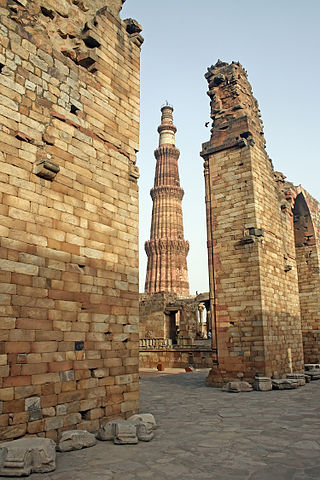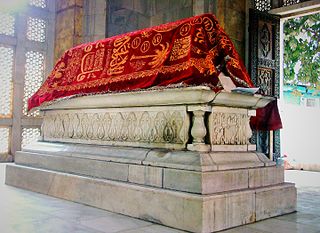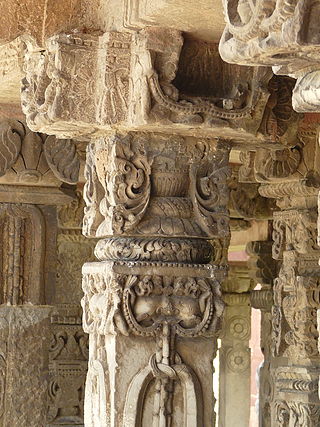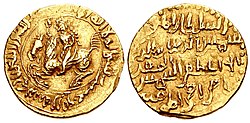
The Delhi Sultanate or the Sultanate of Delhi was a late medieval empire primarily based in Delhi that stretched over large parts of the Indian subcontinent, for 320 years (1206–1526). Following the invasion of South Asia by the Ghurid dynasty, five dynasties ruled over the Delhi Sultanate sequentially: the Mamluk dynasty (1206–1290), the Khalji dynasty (1290–1320), the Tughlaq dynasty (1320–1414), the Sayyid dynasty (1414–1451), and the Lodi dynasty (1451–1526). It covered large swaths of territory in modern-day India, Pakistan, and Bangladesh as well as some parts of southern Nepal.

The Qutb Minar complex are monuments and buildings from the Delhi Sultanate at Mehrauli in Delhi, India. Construction of the Qutub Minar "victory tower" in the complex, named after the religious figure Sufi Saint Khwaja Qutbuddin Bakhtiar Kaki, was begun by Qutb-ud-din Aibak, who later became the first Sultan of Delhi of the Mamluk dynasty. It was continued by his successor Iltutmish, and finally completed much later by Firoz Shah Tughlaq, a Sultan of Delhi from the Tughlaq dynasty (1320–1412) in 1368 AD. The Qubbat-ul-Islam Mosque, later corrupted into Quwwat-ul Islam, stands next to the Qutb Minar.
The Qutb Minar, also spelled Qutub Minar and Qutab Minar, is a minaret and "victory tower" that forms part of the Qutb complex, which lies at the site of Delhi's oldest fortified city, Lal Kot, founded by the Tomar Rajputs. It is a UNESCO World Heritage Site in the Mehrauli area of South Delhi, India. It was mostly built between 1199 and 1220, contains 399 steps, and is one of the most visited tourist spots in the city. Qutab-ud-din Aibak initiated construction of the Qutub Minar, but only managed to finish the first level. His later rulers continued the construction, and in 1368, Firuz Shah Tughlaq rebuilt the top parts and added a cupola.

Mu'izz al-Din Muhammad ibn Sam, also known as Muhammad of Ghor or Muhammad Ghori, was a ruler from the Ghurid dynasty based in the Ghor region of what is today central Afghanistan who ruled from 1173 to 1206. Muhammad and his elder brother Ghiyath al-Din Muhammad ruled in a dyarchy until the latter's death in 1203. Ghiyath al-Din, the senior partner, governed the western Ghurid regions from his capital at Firozkoh whereas Muhammad extended Ghurid rule eastwards, laying the foundation of Islamic rule in South Asia, which lasted after him for nearly half a millennium under evolving Muslim dynasties.

Shams ud-Din Iltutmish was the third of the Mamluk kings who ruled the former Ghurid territories in northern India. He was the first Muslim sovereign to rule from Delhi, and is thus considered the effective founder of the Delhi Sultanate.
Mongol ruler Ghazan Khan converted to Islam.

Qutb ud-Din Aibak was a general of the Ghurid emperor Muhammad Ghori. He was in charge of the Ghurid territories in northern India, and after Muhammad Ghori's assassination in 1206, he established the Delhi Sultanate (1206–1526), and started the Mamluk dynasty, which would rule the Sultanate until 1290.

The Khalji or Khilji dynasty was a Turco-Afghan dynasty that ruled the Delhi Sultanate for three decades between 1290 and 1320. It was the second dynasty to rule the Delhi Sultanate which covered large swaths of the Indian subcontinent. It was founded by Jalal ud din Firuz Khalji.
The Ghurid dynasty was a Persianate dynasty of presumably eastern Iranian Tajik origin, which ruled from the 8th-century in the region of Ghor, and became an Empire from 1175 to 1215. The Ghurids were centered in the hills of the Ghor region in the present-day central Afghanistan, where they initially started out as local chiefs. They gradually converted to Sunni Islam after the conquest of Ghor by the Ghaznavid ruler Mahmud of Ghazni in 1011. The Ghurids eventually overran the Ghaznavids when Muhammad of Ghor seized Lahore and expelled the Ghaznavids from their last stronghold.
Aram Shah was the second Sultan of the Delhi Sultanate. He briefly held the throne from Lahore after the unexpected death of Qutb ud-Din Aibak before being defeated and dethroned by Iltutmish who began ruling from Delhi.

Muiz ud-Din Bahram was the sixth sultan of the Mamluk Dynasty.

Nasir ud din Mahmud Shah was the eighth sultan of the Mamluk Sultanate. The Tabaqat-i Nasiri, written by the court historian Minhaj-i-Siraj, is dedicated to him. His father-in-law Ghiyas ud din Balban handled the state affairs during his reign.
Muiz ud din Qaiqabad was the tenth sultan of the Mamluk dynasty. He was the son of Bughra Khan the Independent sultan of Bengal, as well as grandson of Ghiyas ud din Balban (1266–1287).
Nasir-ud-Din Qabacha or Kaba-cha was the Muslim governor of Multan, appointed by the Ghurid ruler Muhammad Ghori in 1203.

Taj al-Din Yildiz was a Turkic ghulam of the Ghurid dynasty, who, after the death of Sultan Muhammad of Ghor, became the de facto ruler of Ghazni, while, however, still recognizing Ghurid authority.
The Khalji dynasty was the first Muslim dynasty to rule the Bengal region in the Indian subcontinent. The dynasty, which hailed from the Garmsir region of present-day Afghanistan, was founded in 1204 by Muhammad Bakhtiyar Khalji, a Muslim Turko-Afghan general of the Ghurid Empire. The Khaljis initially pledged allegiance to Sultan Muhammad of Ghor until his death in 1206, though their rule in Bengal was mostly independent. Under the rule of Iwaz Khalji, Bengal experienced major developments such as its first naval force, flood defence systems and linkage with the Grand Trunk Road. The dynasty was based in the city of Lakhnauti in northern Bengal, later expanding eastwards and southwards. Nasiruddin Mahmud, the son of Mamluk sultan Iltutmish of Delhi managed to conquer Bengal in 1227; although the Khaljis briefly reasserted their independence, they surrendered to the Mamluks in 1231, who replaced them with a series of regional governors.
Turkic peoples have historically been associated as one of the non-native peoples to have ruled areas of the Indian subcontinent. Various dynasties of the later medieval era and early modern era in India were of Turkic and mixed Indian or Afghan descent. Two of the dynasties of the Delhi Sultanate, viz. the Tughlaqs and Khaljis, for instance, were of mixed Turkic origin, with Indian and Afghan ancestry respectively. The terms Indo-Turkic or Turco-Indian is used to refer to people and dynasties of mixed Turkic and Indian descent, as well as the fusion culture formed as a result.

Malik Bahauddin Tughril, commonly known as Bahauddin Tughril or Baha al-Din Tughril was a senior Turkic slave of the Ghurid ruler Muhammad of Ghor who was in charge of the Bayana region in the present-day Indian state of Rajasthan. He was admitted into the slave-household of the Ghurids during early reign of Muhammad of Ghor and gradually emerged as one of his eminent slave lieutenant along with Qutb al-Din Aibak, playing a significant role in the Ghurid conquest of northern Indian plain.

The siege of Gwalior was a military expedition of The Ghurid Dynasty aganist the Kachchhapaghata dynasty in 1196. The Ghurids under Qutb ud-Din Aibak captured Gwalior after defeating Sulakshanapala, the King of Kachchhapaghata. Sulakshanapala surrendered to Aibak, which led to the complete end of Rajput Kachchhapaghata dynasty

The Khalji Revolution, alternatively spelled the Khilji Revolution, marked a military coup and a period of political and societal transformation in the Delhi Sultanate. It unfolded following the death of Mamluk sultan Balban and the subsequent incapacity of his successors to effectively govern the Delhi Sultanate. The upheaval commenced and concluded in 1290 when Jalaluddin Khalji seized absolute power, toppling the Mamluks and inaugurating the rule of the Khalji dynasty.

























